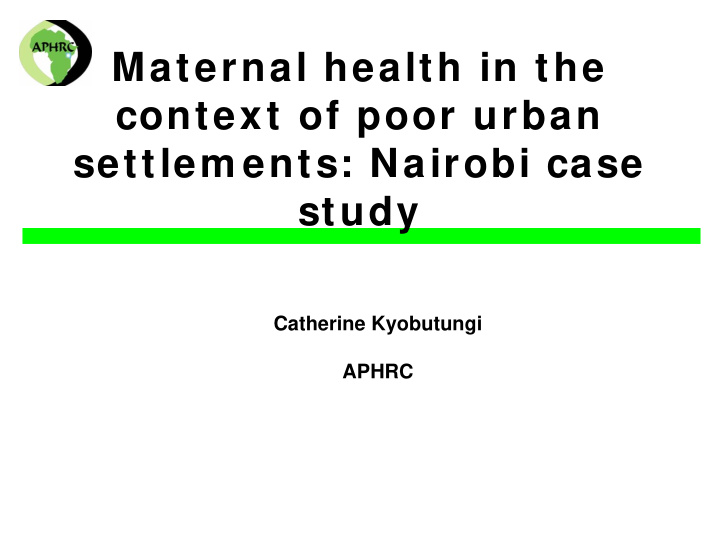



Maternal health in the context of poor urban settlem ents: Nairobi case study Catherine Kyobutungi APHRC
Outline •Country Context – Kenya •Magnitude of maternal ill health at different levels • Contraceptive use • Teenage fertility • ANC and delivery care • Maternal mortality • Beyond the numbers – Quality of care • What can be done? 2
Country Context - Kenya •MMR: 488 (2008) up from 414 (2003) according to KDHS • Urbanisation: • Current urban population in Kenya: 22 to 35% • Annual urbanisation rate: 4.0% • Population growth rate: 2.6% • About 60% of urban residents in Kenya live in slums or slum-like conditions [ UN Habitat 2 0 0 8 ] • By 2050, half of the population in the region will leave in urban areas 3
Context and Data Sources •The Nairobi Urban Health and Demographic Surveillance System (NUHDSS) • Since January 2003 • Population under observation - ~ 60,000 • Demographic events (Deaths, Birth, Migratory movements) recorded three times a year • Verbal autopsy • Health Facility Survey for maternal health services • Kenya Demographic and Health Surveys 4
Maternal Health Outcom es More Proximal Outcomes •Contraceptive use •Teenage pregnancy Intermediate outcomes •Timing and frequency of antenatal care •Use of skilled attendant during delivery Ultimate outcome – maternal mortality 5
Maternal Health Outcomes Contraceptive Prevalence Rate, 1993 ‐ 2008 6 Sources: KDHS - various
Maternal Health Outcomes Total Fertility Rate 7
Maternal Health Outcomes Teenage pregnancy/motherhood by place of residence 1993 to 2008 8 Sources: KDHS - various
Maternal Health Outcom es Delivery with skilled attendant ANC with skilled attendant 100 100 80 80 60 60 40 40 20 20 0 0 Slums Nairobi Urb Kenya Rur Kenya Slums Nairobi Urb Kenya Rur Kenya Antenatal Care with HP Delivery with HP � Percentage of women who sought antenatal care with health professional (HP) quite high � 70% delivered with the assistance of HP, compared with ~80% in Nairobi as a whole 9
Maternal Health Outcomes Timing of antenatal care 60 50 40 30 20 10 0 Slums (2004/05) Urb Kenya (2003) Rur Kenya (2003) <4 months '4-5 '6-7 '8+ � Only 7.5% of slum women had their first ANC visit during the first trimester of pregnancy (17% in urban Kenya and 11% in rural Kenya
Maternal Health Outcomes Frequency of antenatal care 80 70 60 50 40 30 20 10 0 Slums (2004/05) Urb Kenya (2003) Rur Kenya (2003) 1 visit '2-3 visits '4+ visits � Only 54% of slum women had 4+ ANC visits (71% in urban Kenya and 54% in rural Kenya
Maternal Health Outcom es Maternal mortality and delayed maternal mortality 12 Sources: KDHS – various and NUHDSS
Maternal Health Outcom es Maternal deaths, health care utilisation and causes Maternal Other pregnancy death Late MD outcome Delivered by health professional No 79.3 68.2 33.1 Yes 20.7 31.8 66.9 Place of delivery Outside of health care facility 86.2 90.9 35.3 Health care facility 13.8 9.1 64.7 Outcome of pregnancy Abortion/still birth 69.0 13.6 1.3 Live birth 31.0 86.4 98.7 Place of death Outside health care facility 37.9 68.2 - Health care facility 62.1 31.8 - Sought care before death No 13.8 4.6 - Yes 86.2 95.5 -
Beyond utilisation num bers • Evident high use of skilled health care workers for ANC • Very high use of skilled attendants at delivery • ..However… … definition of “ skilled” questionable • Quality of easily accessible health facilities poor • Near absent public sector • Prolific private sector • Other barriers 14
Skilled Birth Attendants 15
The State of MHS � 25 MHFs (including 4 hospitals: KNH; Pumwani, St Mary, Kiambu DH) � Among the 21 non ‐ hospital facilities: • Only 4 had an obstetrician • Only 8 had a doctor • Some did not have qualified nurse or midwifes • Some did not have printed referral form • 7 did not have piped water in the facility/compound Based on survey of mothers who • 7 did not have infection delivered in 2005 to 2006 control guidelines 16
The State of MHS Size and quality of services in private sector vary widely 17
Other Barriers � Cost – very high uptake of output ‐ based Aid voucher scheme � Transport – poor road infrastructure From here one has to go to Kenyatta or Pumwani and we really do not have the money to take us there. If you get complications late in the night traveling from here to Pumwani is far and risky. There are many thugs on the way. The road is bad and there is no way you can get a vehicle to come this far in the community to carry your patient. If only there would be some good facilities at Makadara, at least is a bit nearer but still not near enough. The facilities there are not enough and after two hours without delivering they will still take you to Pumwani and that is the expense of the family or friends” ( Viwandani FGD, Female Opinion Leaders). � Insecurity – “ We have thugs at night along the way. Both women and men fear and it is hard for them to come out and assist. Most night deliveries happen in the homes instead because of these reasons ” ( Korogocho ) FGD, Females 20 ‐ 29 years � Poor attitudes of health care providers 18
Some Thoughts on What can be Done � Support to the private sector • Training • Equipment and infrastructure • Supplies • Supervision and regulation � Improve health service regulatory environment � Strengthen local health service governance structures � Address issues of insecurity 19
Thank You! 20
Recommend
More recommend